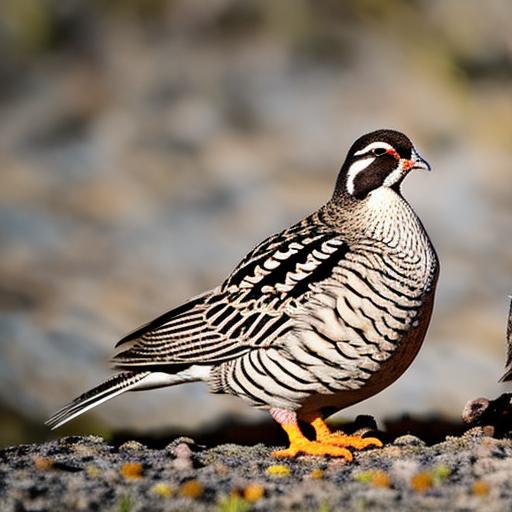Male quails, like many other bird species, have specific behaviors that are important to understand when keeping them together. Male quails are known for their territorial nature, especially during the breeding season. They can become aggressive towards other males in order to establish dominance and secure mating opportunities with females. This behavior is natural and should be expected when keeping male quails together. Additionally, male quails are also known for their vocalizations, which can be quite loud and frequent, especially during the breeding season. Understanding these behaviors is crucial for creating a suitable environment for male quails and managing their interactions with each other.
Male quails also have a strong social hierarchy within their group. They will establish a pecking order, with dominant males asserting their authority over subordinate males. This hierarchy is important for maintaining order within the group and reducing the likelihood of aggressive behavior. It’s important to recognize and respect this social structure when keeping male quails together, as disrupting the hierarchy can lead to increased aggression and stress among the birds. Understanding the natural behaviors and social dynamics of male quails is essential for creating a harmonious environment for them to live in.
Key Takeaways
- Male quails are territorial and can display aggressive behavior, especially during mating season.
- Factors to consider when keeping male quails together include providing enough space, hiding spots, and a balanced diet.
- Tips for keeping male quails together include introducing them at a young age, providing multiple feeding and watering stations, and monitoring their behavior regularly.
- Signs of aggression in male quails include pecking, chasing, and feather plucking.
- Creating a suitable environment for male quails involves providing a spacious and well-structured enclosure with proper lighting and ventilation.
- When introducing new male quails to an existing group, it’s important to do so gradually and monitor their interactions closely.
- Seeking professional advice for male quail care is recommended, especially if dealing with aggression or other behavioral issues.
Factors to consider when keeping male quails together
When keeping male quails together, there are several important factors to consider in order to ensure their well-being and minimize the risk of aggression. One key factor is the size of the enclosure. Male quails need enough space to establish their territories and maintain a safe distance from each other. Overcrowding can lead to increased aggression and stress, so it’s important to provide ample space for the birds to move around and establish their own territories within the enclosure.
Another important factor to consider is the ratio of males to females in the group. Male quails can become more aggressive when competing for the attention of females, so it’s important to maintain a balanced ratio to reduce tension within the group. Additionally, providing plenty of hiding spots and visual barriers within the enclosure can help reduce confrontations between males by allowing them to establish their own personal space and avoid direct confrontations.
It’s also important to consider the age and health of the male quails when keeping them together. Older or sickly males may be more vulnerable to aggression from younger, healthier males, so it’s important to monitor their interactions closely and provide any necessary medical care or separation if needed. By considering these factors, you can create a more harmonious environment for male quails to live together.
Tips for keeping male quails together
When keeping male quails together, there are several tips that can help minimize aggression and create a more harmonious living environment for the birds. One important tip is to provide multiple feeding and watering stations within the enclosure. This can help reduce competition for resources and minimize confrontations between males. Additionally, providing a varied diet with plenty of protein can help reduce aggressive behavior by ensuring that all the birds are well-nourished and less likely to compete for food.
Another tip is to provide plenty of hiding spots and visual barriers within the enclosure. This can help reduce confrontations between males by allowing them to establish their own personal space and avoid direct confrontations. Providing ample space for the birds to move around and establish their territories within the enclosure is also crucial for minimizing aggression.
Regular monitoring of the birds’ behavior is essential for identifying any signs of aggression or stress. By observing their interactions closely, you can intervene if necessary to prevent any serious conflicts from escalating. It’s also important to provide regular enrichment activities, such as dust baths and foraging opportunities, to keep the birds mentally stimulated and reduce boredom-related aggression.
Signs of aggression in male quails
It’s important to be able to recognize the signs of aggression in male quails in order to intervene and prevent serious conflicts from escalating. One common sign of aggression in male quails is excessive pecking or chasing behavior towards other males. This can indicate that a dominant male is asserting its authority over subordinate males and may lead to serious confrontations if not addressed.
Another sign of aggression is excessive vocalizations, such as loud and frequent calling or crowing. This can indicate that the birds are feeling stressed or threatened, which may lead to increased aggression towards each other. Additionally, any signs of injury or feather damage should be taken seriously, as they may indicate that serious conflicts have occurred within the group.
It’s important to monitor the birds’ behavior closely and intervene if necessary to prevent any serious conflicts from escalating. Providing plenty of hiding spots and visual barriers within the enclosure can help reduce confrontations between males by allowing them to establish their own personal space and avoid direct confrontations. By recognizing these signs of aggression and taking proactive measures to address them, you can create a more harmonious living environment for male quails.
Creating a suitable environment for male quails
Creating a suitable environment for male quails is crucial for minimizing aggression and ensuring their well-being. One key aspect of creating a suitable environment is providing ample space within the enclosure. Male quails need enough space to establish their territories and maintain a safe distance from each other in order to reduce tension and minimize confrontations.
Another important aspect is providing plenty of hiding spots and visual barriers within the enclosure. This can help reduce confrontations between males by allowing them to establish their own personal space and avoid direct confrontations. Additionally, providing multiple feeding and watering stations can help reduce competition for resources and minimize confrontations between males.
It’s also important to provide regular enrichment activities, such as dust baths and foraging opportunities, to keep the birds mentally stimulated and reduce boredom-related aggression. Providing a varied diet with plenty of protein can also help reduce aggressive behavior by ensuring that all the birds are well-nourished and less likely to compete for food.
Introducing new male quails to an existing group

Introducing new male quails to an existing group requires careful planning and monitoring in order to minimize aggression and ensure a smooth transition. One important step is to quarantine the new birds in a separate enclosure for a period of time before introducing them to the existing group. This can help prevent the spread of any potential diseases or parasites and allow the new birds to acclimate to their new environment before interacting with the existing group.
When introducing the new birds to the existing group, it’s important to do so gradually and under close supervision. Providing plenty of hiding spots and visual barriers within the enclosure can help reduce confrontations between the new and existing birds by allowing them to establish their own personal space and avoid direct confrontations. It’s also important to monitor their interactions closely and intervene if necessary to prevent any serious conflicts from escalating.
Additionally, providing multiple feeding and watering stations can help reduce competition for resources and minimize confrontations between the new and existing birds. By taking these steps, you can help minimize aggression and ensure a smooth integration of new male quails into an existing group.
Seeking professional advice for male quail care
Seeking professional advice for male quail care is important for ensuring their well-being and minimizing the risk of aggression. A veterinarian with experience in avian care can provide valuable guidance on creating a suitable environment for male quails, identifying signs of aggression, and addressing any health concerns that may contribute to aggressive behavior.
Additionally, seeking advice from experienced bird keepers or breeders can provide valuable insights into managing male quail behavior and creating a harmonious living environment for them. These individuals may have practical tips and strategies based on their own experiences that can help minimize aggression and promote the well-being of male quails.
By seeking professional advice for male quail care, you can gain valuable knowledge and support that can help you create a suitable environment for your birds and address any behavioral or health concerns that may arise. This proactive approach can help ensure the well-being of your male quails and promote a harmonious living environment for them.
If you’re considering keeping male quails together, it’s important to understand their social dynamics and space requirements. To ensure a harmonious living environment, it’s crucial to provide adequate space and resources for each bird. For more insights on creating a suitable living space for poultry, check out this informative article on chicken coop interior ideas. Understanding the needs of your quails and providing a well-designed living space can contribute to their overall well-being and happiness.
FAQs
Can you keep male quails together?
Yes, male quails can be kept together in the same enclosure as long as there is enough space and resources for each bird.
What should be considered when keeping male quails together?
When keeping male quails together, it is important to provide enough space, hiding spots, and resources such as food and water to prevent aggression and territorial behavior.
What are the potential challenges of keeping male quails together?
Potential challenges of keeping male quails together include aggression, fighting, and dominance behavior, especially during breeding season. It is important to monitor the birds closely and be prepared to separate them if necessary.
Are there any specific breeds of male quails that are more suitable for being kept together?
Some breeds of male quails may be more tolerant of being kept together, but individual temperament and behavior can vary. It is important to observe the birds and their interactions to determine if they can be kept together peacefully.
What are some signs of aggression or stress in male quails kept together?
Signs of aggression or stress in male quails kept together may include pecking, chasing, puffing up feathers, and vocalizing aggressively. It is important to intervene if these behaviors are observed to prevent injury to the birds.
Meet Walter, the feathered-friend fanatic of Florida! Nestled in the sunshine state, Walter struts through life with his feathered companions, clucking his way to happiness. With a coop that’s fancier than a five-star hotel, he’s the Don Juan of the chicken world. When he’s not teaching his hens to do the cha-cha, you’ll find him in a heated debate with his prized rooster, Sir Clucks-a-Lot. Walter’s poultry passion is no yolk; he’s the sunny-side-up guy you never knew you needed in your flock of friends!







